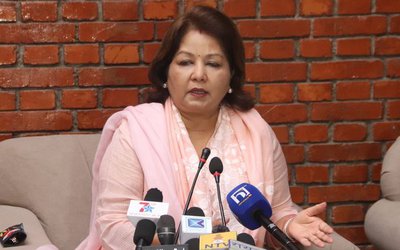
In Global Hunger Index (GHI) 2021, Nepal has improved its position. However, India slipped to 101st position in the GHI out of 116 countries, from its 2020 position of 94th, and is behind its neighbors Pakistan, Bangladesh and Nepal.
Global Hunger Report 2021 has lowered the rank of India on the basis of FAO estimate on proportion of undernourished population, which is found to be “devoid of ground reality and facts and suffers from serious methodological issues.”
Oxfam India said the GHI data which states that India dropped to the hunger-level ranks by seven spots to the 101st spot “unfortunately reflects the reality of the country where hunger accentuated since the Covid-19 pandemic.”
However, Nepal secured lower mark than India, Bangladesh, Pakistan and Sri Lanka in Global Food Supply Index.
According to the report, India held 71st position with an overall score of 57.2 points on the GFS Index 2021 of 113 countries, fared better than Pakistan (75th position), Sri Lanka (77th Position), Nepal (79th position) and Bangladesh (84th position). But the country was way behind China (34th position).
In the food affordability category, Pakistan (with 52.6 points) scored better than India (50.2 points). Sri Lanka was also better at 62.9 points on the GFS Index 2021.
In case of availability of food, quality and safety as well as protecting natural resources for food production, India scored better than Pakistan, Nepal, Bangladesh and Sri Lanka on the GFS Index 2021, the report added.
However, over the past 10 years, India’s incremental gains in overall food security score were lagging behind that of Pakistan, Nepal and Bangladesh.
India’s score improved only by 2.7 points to 57.2 in 2021 from 54.5 in 2012 when compared with Pakistan by 9 points (to 54.7 in 2021 from 45.7 in 2012) while that of Nepal by 7 points (to 53.7 points in 2021 from 46.7 points in 2012) and Bangladesh by 4.7 points (to 49.1 in 2021 from 44.4 points in 2012).
However, the POSHAN Abhiyaan launched in 2017 to improve nutrition among children, pregnant women and lactating mothers, has languished due to poor funding resulting from clever clubbing with other schemes within the health-budget and even worse implementation.
Only 0.57 per cent of the current budget has been allocated towards funding the actual POSHAN scheme and the amount for child nutrition dropped by a whopping 18.5 per cent compared to 2020-21, Oxfam India said in a statement.
“There are massive negative consequences to not arresting high levels of malnutrition. In India, both our adult population and children are at risk. For instance, the BMI of a quarter of our (teenage and middle aged) women is below the standard global norm, more than half of our women suffer from anaemia.
A quarter of our (teenage and middle-aged) men also show signs of iron and calcium deficiencies as per the latest round of NHFS data, said Varna Sri Raman, Lead, Research and Knowledge Building at Oxfam India.
The GHI report, prepared jointly by Irish aid agency Concern Worldwide and German organization Welt Hunger Hilfe, termed the level of hunger in India
Ireland, Australia, the UK, Finland, Switzerland, the Netherlands, Canada, Japan, France and the US shared the top rank with the overall GFS score in the range of 77.8 and 80 points on the index.
The GFS Index was designed and constructed by London-based Economist Impact and is sponsored by Corteva Agriscience.
The GFS Index measures the underlying drivers of food security in 113 countries, based on the factors of affordability, availability, quality and safety, and natural resources and resilience. It considers 58 unique food security indicators including income and economic inequality – calling attention to systemic gaps and actions needed to accelerate progress toward United Nations Sustainable Development Goal of Zero Hunger by 2030.
China’s score improved by 9.6 points to 71.3 in 2021 from 61.7 in 2012, the report said. “The GFSI looks beyond hunger to identify the underlying factors affecting food insecurity around the world,” said Tim Glenn, Executive Vice-President and Chief Commercial Officer, Corteva Agriscience.
The findings of GFS Index 2021 also showed that global food security has decreased for the second year in a row after seven years of progress towards the Sustainable Development Goal of achieving zero hunger by 2030.
According to Pratima Singh, Head of the Global Food Security Index at Economist Impact, “The index shows that, while countries have made significant strides toward addressing food insecurity in the past ten years, food systems remain vulnerable to economic, climatic, and geopolitical shocks. Action is imperative at all levels–local, national, and global–to end hunger and malnourishment and ensure food security for all.”
In its global report, Economist Impact stated that the Index shows that to meet these present and emerging future challenges requires that investments in food security are sustained – from innovation in climate-resilient crop yields to investing in programs to assist the most vulnerable.
- NEPAL-THAILAND: Joint Business Council
- Apr 13, 2025
- BIMSTEC SUMMIT: Nepal’s Stand
- Apr 11, 2025
- IME GROUP: Expands Into Paper Industry
- Mar 24, 2025
- CPN UML: Instigated By India
- Mar 23, 2025
- ADB’S CHIEF ECONOMIST: Nepal Reduces Poverty
- Mar 11, 2025















